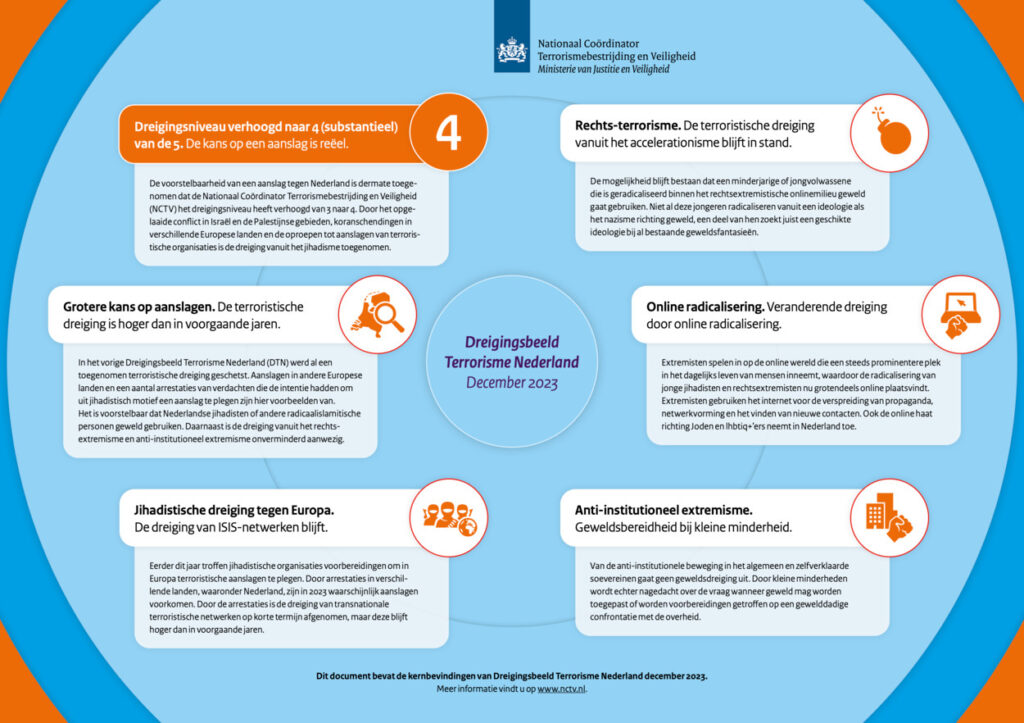Language:

Terrorism in Security Plans: A Necessary Evolution in Event Safety
Source photo: Design Rctapilaha
In the dynamic world of event organization, applying for a permit is not merely a formality but an essential step in ensuring the safety of all involved. This obligation applies particularly to events that attract a significant number of visitors, where the threshold for ‘significant’ varies depending on local regulations and the nature of the event.
In the Netherlands, we generally use a three-tier categorization of events:
- A-events: These are small-scale events with a maximum of 2000 visitors. Think of local markets, smaller music performances, or neighborhood festivals.
- B-events: These medium-sized events attract between 2000 and 25,000 visitors. Examples include larger music festivals, sporting events, or cultural manifestations.
- C-events: Large-scale events with more than 25,000 visitors fall into this category. These include major music festivals, national celebrations, or international sporting events.
For B and C events, submitting a detailed security plan as part of the permit application is an absolute requirement. This plan serves as a blueprint for all safety measures and procedures that will be in effect during the event.
The security plan undergoes a thorough assessment procedure involving various authorities. The municipality, as the primary permit issuer, often takes the lead. Additionally, the police and fire department play a crucial role in assessing public order and fire safety aspects, respectively. In some cases, especially for events where health risks are a factor, the local health authority (GGD) is also involved in the assessment.
This multi-disciplinary approach ensures that every aspect of safety – from crowd control to emergency procedures – is thoroughly evaluated. The goal is not only to identify potential risks but also to ensure that adequate measures are in place to mitigate these risks.
The importance of this procedure cannot be overstated. In an era where mass gatherings are becoming increasingly complex and potential risks are on the rise, the security plan forms the backbone of responsible event organization. It enables organizers to act proactively and be prepared for a wide range of scenarios, from minor incidents to large-scale calamities.
The Anatomy of an Effective Security Plan
Creating a security plan can be a challenging undertaking for many event organizers. It requires not only a thorough knowledge of the event itself but also insight into potential risks and best practices in safety management. Fortunately, organizers don’t have to go through this process entirely on their own.
There is a range of resources available to support organizers in this crucial task. Many municipalities and safety regions offer templates on their websites that can serve as a starting point for the security plan. These templates vary in complexity and detail:
- Some provide a simple chapter outline that can serve as a guide for the structure of the plan.
- Others go a step further and offer examples and suggestions for filling in each chapter.
- There are even interactive formats available in the form of extensive questionnaires that guide organizers step by step through the process.
Despite this variation in form, most security plans show a high degree of similarity in content. A typical security plan includes the following core components:
- Event Description: This section provides a detailed overview of the event. It includes not only practical information such as date, location, and expected number of visitors but also outlines the character of the event, the target audience, and any special features that may affect safety.
- Organizational Structure: Here, a clear organizational chart is presented that shows the hierarchy and responsibilities within the organization. It is crucial that there is clarity about who makes which decisions, especially in emergency situations.
- Risk Assessment: This is one of the most critical parts of the plan. Here, all possible risks are identified and analyzed. For each identified risk, preventive measures and response procedures are then developed.
- Security: This chapter delves into the security plan and personnel. It describes not only the number of security guards and their positions but also their tasks, authorities, and communication lines.
- Crowd Management: Here, strategies are outlined for managing visitor flows. This includes matters such as access control, walking routes, and procedures in case evacuation is necessary.
- First Aid and Medical Provisions: This section describes the available medical assistance, from first aid posts to procedures for calling in professional emergency services.
- Traffic and Transport: Here, plans are described for the arrival and departure of visitors, including parking facilities, public transport, and traffic management.
- Emergency Plan: This crucial component describes the procedures that come into effect in various types of emergency situations, from fires to serious public order disturbances.
- Communication Plan: Here, both internal and external communication strategies are outlined. This includes communication between staff, with emergency services, and with the public in case of calamities.
To provide practical support for the readers of this article, I have included several examples of security plans that can be downloaded. These examples not only illustrate the standard topics included in a security plan but also demonstrate how the format can vary between different municipalities and safety regions.
It’s important to emphasize that a security plan is not a static document. It must be regularly evaluated and updated to remain relevant and respond to new insights or changing circumstances. A good security plan is the cornerstone of a safe and successful event.

Terrorism – The Missing Puzzle Piece in Security Plans
In the world of event safety, there is one crucial element often overlooked in standard security plans: terrorism. While we focus on crowd control, fire safety, and medical emergencies, the threat of terrorism sometimes seems to be a blind spot in our safety considerations. However, recent events in Europe underscore the need to take this threat seriously and integrate it into our safety planning.
Let’s look at some alarming incidents from the past year:
- In December 2023, news shocked France when media reported that five arrests had been made in connection with a planned attack on a Christmas market in Nancy. This incident reminded many of the tragic attack on the Christmas market in Strasbourg in 2018.
- The 2024 European Football Championship in Germany was nearly the scene of a catastrophe. On June 8, 2024, the German newspaper Bild reported that German police and intelligence services had managed to thwart a planned attack on the tournament. This news sent shockwaves through the football world and highlighted the vulnerability of major sporting events.
- The memory of the tragic events during the Gay Pride in Oslo in 2022 became relevant again when on July 4, 2024, the perpetrator was sentenced to 30 years in prison. This verdict underscored the lasting impact of terrorist acts on communities and events.
- The 2024 Olympic Games in Paris escaped multiple potential disasters. On July 5, 2024, the French Minister of the Interior announced that five arrests had been made in the days leading up to the Games in connection with planned terrorist attacks. Later, on September 11, the French press reported that security services had managed to foil at least three attacks during the Games.
- The music world was shocked when on August 8, 2024, three Taylor Swift concerts in Vienna, Austria, were canceled due to a concrete terror threat. This incident showed how terrorist threats not only have a direct impact on safety but also on the cultural and economic aspects of events.
- A poignant example of how quickly a festive occasion can turn into a tragedy occurred on August 23, 2024. During a festival celebrating the 650th anniversary of the German city of Solingen, three people were fatally stabbed. Another eight people were injured, five of them seriously. This incident underscored the need for thorough safety measures, even at seemingly innocent local celebrations.
This series of events, all occurring within a timespan of less than a year, is just the tip of the iceberg. They represent a fraction of the planned or executed attacks with a terrorist motive in Europe. What these incidents have in common, besides their terrorist nature, is their direct connection to events. Whether it’s large-scale international sporting events, cultural festivals, or local celebrations, they all show the attraction of public gatherings as potential targets for terrorist activities.
It’s understandable that terrorism forms an integral part of security planning for mega-events like the Olympic Games. But what about the countless smaller and medium-sized events that take place daily in the Netherlands? Are the lessons we can draw from these European examples sufficiently integrated into our local security plans?
This question brings us to a crucial consideration: isn’t it time to include terrorism and related threats as a standard component in the security plans submitted with permit applications for events in the Netherlands? Ignoring this reality in our safety planning seems, in light of the current European situation, a potentially dangerous omission.
The DTN: The Netherlands’ Barometer for Terrorist Threat
To understand the necessity of integrating terrorism prevention into event safety, it is crucial to highlight the current state of affairs in the Netherlands. Currently, our country is at level 4 of the 5-point Terrorist Threat Assessment Netherlands (DTN) scale.
The DTN is an essential tool in the Dutch security landscape. Prepared by the National Coordinator for Security and Counterterrorism (NCTV), it provides an in-depth analysis of the terrorist threat against the Netherlands. This report, which is periodically updated, serves as a guide for policymakers, security services, and, increasingly, for organizers of public events.
The five levels of the DTN are as follows:
- Minimal: There is no terrorist threat.
- Limited: The chance of an attack is small but not ruled out.
- Substantial: An attack is conceivable.
- Significant: The chance of an attack is real.
- Critical: There are concrete indications that an attack is imminent or may have already occurred.

The fact that the Netherlands is currently at level 4 is worrying; this level implies that there are concrete indications that terrorist groups have both the intention and the capacity to carry out attacks within our borders. It means that threats are no longer hypothetical; they now pose a real danger to our society.
This situation requires increased vigilance from all parties involved. For event organizers, this means they can no longer rely on traditional security measures; they must proactively think about how to protect their events against potential terrorist threats.
It is important to emphasize that all of this should not create panic but rather awareness. By realistically looking at threats and responding adequately, we can significantly increase safety around our events.
The Need for Terrorism as a Standard Component in Security Plans
The frequency and severity of terrorist threats and attacks in Europe, combined with the current DTN level in the Netherlands, make one thing clear: it is time to include terrorism as a standard component in security plans for events. Ignoring this is not only irresponsible but can also have serious consequences for both visitor safety and the reputation of organizers.
Events are particularly vulnerable targets for terrorist activities. The large numbers of people gathering during festivals, sporting events, or cultural manifestations create ideal conditions for chaos to ensue. A single attack can not only lead to loss of life but also cause long-term damage to communities and involved organizations. Therefore, organizers must be aware of the risks and take appropriate measures.
Given the DTN level four, I advise integrating terrorism prevention as a standard in every security plan. Should the threat level decrease, municipalities or safety regions can determine whether the topic of terrorism can be removed from the plan. This keeps the topic dynamic, depending on the current situation.
Including this also offers advantages in terms of safety; moreover, it exudes confidence to visitors. It will also signal to potential individuals with terrorist motives that the event takes into account the possibility of an attack. This could even have a deterrent effect; potential perpetrators might think twice before taking action.
Expertise in the Field of Terrorism
When integrating terrorism into the security plan, municipalities and safety regions will still need to determine what exactly should be included. Terrorism and related topics have many overlaps with the components already included in the security plan. Take, for example, the topic of Traffic and Transport: here, one could include the placement of concrete barriers; from a terrorism prevention perspective, this would prevent a vehicle from penetrating the crowd.
However, specific knowledge about terrorism remains scarce. Just as external expertise is called upon for traffic, transport, or first aid, specialist knowledge will also be needed for the topic of terrorism.
As a Radicalization and Terrorism Expert (RTE), I offer event organizers the opportunity to make use of my expertise in integrating anti-terrorism measures into their plans. My role includes several important services:
- Risk Analysis: I assist organizers in conducting detailed risk analyses, specifically focused on possible terrorist threats. Here, we look at the nature of the event, location, expected visitor numbers, and other relevant factors.
- Advice on Preventive Measures: Based on the risk analysis, I advise on preventive measures to mitigate potential threats, ranging from security strategies to communication lines.
- Training: I provide training for personnel on recognizing suspicious situations and responding adequately in case of emergency; this increases readiness and strengthens the sense of security among employees.
- Development of Response Procedures: Clear procedures are essential for dealing with terrorist attacks and other emergencies; I help develop and implement these protocols.
- Coordination with Local Authorities: Effective cooperation with local police and security services is essential for good preparation for possible incidents; I facilitate contact between organizers and relevant authorities.
By utilizing this expertise, event organizers can strengthen their plans and better prepare for the challenges associated with modern event safety. In a time when we are increasingly confronted with complex issues, it is essential to remain proactive in safeguarding the well-being of event participants.
Conclusion: Integration of Terrorism Prevention in Event Planning
This blog aims to highlight a crucial point: the absence of terrorism as a topic in the security plan for event permit applications. Given the current DTN level four in the Netherlands, it seems not only desirable but even necessary to include this as a standard component. I hereby make an urgent appeal to municipalities and safety regions to adjust their policies in this direction; such a change will undoubtedly contribute to a safer society for us all.
As a Radicalization and Terrorism Expert, I have outlined various possibilities that I can offer event organizers to effectively integrate the theme of terrorism into their plans. However, it is important to emphasize that these suggestions should not be seen as an absolute standard; the final decision on content and approach lies with the municipalities and regional authorities.
By including terrorism as a standard component in security plans, we can meet current requirements and proactively contribute to a more robust structure around event safety. With the right knowledge, resources, and cooperation between all parties involved, we ensure that events remain unforgettable experiences and safe meeting places where visitors can enjoy themselves with peace of mind.
It is time to face the reality of the current security situation and adjust our policies accordingly. Only by taking joint action can we elevate the safety of our events to a higher level and thereby strengthen the safety of our society as a whole.
